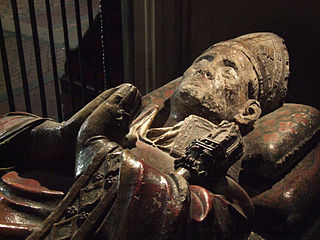Related Research Articles
Paulinus was a Roman missionary and the first Bishop of York. A member of the Gregorian mission sent in 601 by Pope Gregory I to Christianize the Anglo-Saxons from their native Anglo-Saxon paganism, Paulinus arrived in England by 604 with the second missionary group. Little is known of Paulinus's activities in the following two decades.

John Alcock was an English churchman, bishop and Lord Chancellor.
Honorius was a member of the Gregorian mission to Christianize the Anglo-Saxons from their native Anglo-Saxon paganism in 597 AD who later became Archbishop of Canterbury. During his archiepiscopate, he consecrated the first native English bishop of Rochester as well as helping the missionary efforts of Felix among the East Anglians. Honorius was the last to die among the Gregorian missionaries.

John Sheppey was an English administrator and bishop. He served as treasurer from 1356 to 1360. Little is known of his family and background. A Benedictine, he was ordained deacon in 1318, and later studied at Oxford. Later he became involved in royal government, and was made bishop of Rochester on 22 October 1352. He was consecrated on 10 March 1353. He died on 19 October 1360, and was buried in Rochester Cathedral at the altar of St John the Baptist. As his will shows, he was a friend of his predecessor in the treasury, William Edington.
Ithamar was the first bishop in England to be Saxon-born rather than consecrated by the Irish or from among Augustine's Roman missionaries. He was also the first Saxon bishop of Rochester.
Romanus was the second bishop of Rochester and presumably was a member of the Gregorian mission sent to Kent to Christianize the Anglo-Saxons from their native Anglo-Saxon paganism. Romanus was consecrated bishop around 624 and died before 627 by drowning. Little is known of his life beyond these facts.
Putta was a medieval Bishop of Rochester and probably the first Bishop of Hereford. Some modern historians say that the two Puttas were separate individuals.
Edmund Audley was Bishop of Rochester, Bishop of Hereford and Bishop of Salisbury.
Ceollach was a medieval Bishop of Mercia. His consecration dates and death dates are unknown. He was Irish by birth and was trained in Ireland. Before his death, he left or resigned his see and went to the monastery of Iona.

Eadhæd was a medieval Bishop of Lindsey and sole Bishop of Ripon in the Medieval era.
Cyneberht was a medieval Bishop of Lindsey.
Wine was a medieval Bishop of London, having earlier been consecrated the first Bishop of Winchester.
Aldwulf or Ealdwulf was a medieval Bishop of Rochester. He was probably consecrated in 727 and died in 739. According to Bede his consecrator was Archbishop Berctwald.
Eardwulf was a medieval Bishop of Rochester.
Diora was a medieval Bishop of Rochester.
Siward was a medieval Bishop of Rochester.
Lawrence of St Martin was a medieval Bishop of Rochester.
Thomas Ingoldsthorpe was a medieval Bishop of Rochester.

John Low or John Lowe was a medieval Bishop of St Asaph and then Bishop of Rochester, in Wales and England respectively. He was an Augustinian monk and opponent of the Lollard movement.

Richard FitzJames was a medieval Bishop of Rochester, Bishop of Chichester and Bishop of London.
References
- Fryde, E. B.; Greenway, D. E.; Porter, S.; Roy, I. (1996). Handbook of British Chronology (Third revised ed.). Cambridge: Cambridge University Press. ISBN 0-521-56350-X.